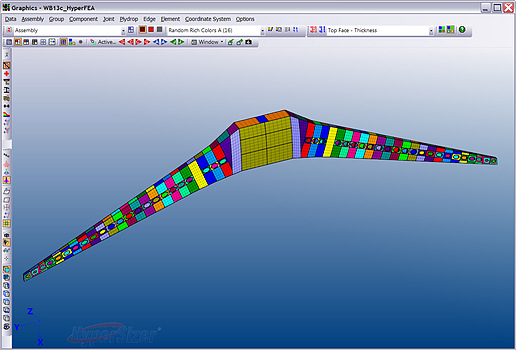Posted on 6/21/2011
Source: SAE International
Composites have now gained wide acceptance and validation in aerospace applications. Their weight-to-strength properties promote fuel efficiency and the achievement of energy targets without impacting durability.
“One of the biggest roadblocks to effective composite design is the inability of engineers to adequately explore optimized layups simultaneously with other design variables.” said Craig Collier, President of Collier Research Corp. “This results in design inefficiencies and compromises.”
To address these issues, Collier Research recently released HyperSizer v6 structural sizing and analysis software. HyperSizer v6 integrates with FEA solvers in a continuous, automated iterative loop, conducting trade studies and examining millions of potential design candidates down to the ply—or even element—level. The software ensures structural integrity through a suite of failure analysis predictions that are validated to test data. The tool also enhances manufacturability by minimizing ply drops, identifying and controlling laminate transition drop/add boundaries, and defining best ply shapes and patterns.
“HyperSizer has an extensive material system library of composite fabrics, tapes, and metallic materials,” Collier said. “Material properties provided by the vendor, such as ply thickness, are included in the database. The library can be customized as well, with new materials and variations that result during manufacturing. For example, if the fabrication technique results in a different thickness, that in-situ measurement can be entered into HyperSizer so that the model can be optimized based on exact values.”
Developed and proven at NASA, the software—the first ever commercialized by the agency—has a track record of 20% weight reduction in government and commercial aerospace projects.
“HyperSizer’s ability to cut significant weight from composite designs has been a foundation capability of the software since we first commercialized it 12 years ago,” Collier said. “The 20% weight savings referred to is a number based on actual project results from customers and collaborators throughout our history. In fact, 20% is conservative; often the savings from an optimization have been even greater.”
Some of the new features in HyperSizer v6 include the capability to identify, define, and control ply-count compatibility, laminate sequencing, interleaving, and ply-drop minimization; automated compression, shear, and compression-shear post-buckling analyses that serve as the foundation for metal aircraft design; and two novel, damage-tolerant composite architectures are now available—PRSEUS, a dry-fabric woven material poltruded rod structure, and “reinforced core sandwich,” an alternative sandwich panel similar to foam sandwich—providing more structural sizing variables and optimization flexibility.
“In earlier versions of HyperSizer, the software focused primarily on minimizing weight in composite structures while maintaining design strength and durability,” Collier said. “In this latest version, we have added the capability of optimizing for manufacturability. What this means is that the software looks to define optimum layup areas and designs for ply-count compatibility across the zones by examining laminate structure details such as ply ordering, ply drops, and interleaving. All of these improvements not only help make the design stronger and lighter but also easier to manufacture, because a more optimized laminate construction means fewer fabrication steps and, therefore, lower cost.”
Serving as the analysis hub and automating data transfer during both design and manufacturing cycles, HyperSizer integrates with FEA software, such as Nastran and Abaqus, and with composite CAD tools, such as CATIA and FiberSIM.
“In general, [HyperSizer] integrates with FEA solvers by importing a finite element model and then statistically post-processing hundreds of mechanical and thermal load sets in an automated iterative loop using HyperFEA to update and converge load paths,” Collier said. “More specifically, for a preliminary design FEM, HyperSizer optimizes each structural component individually, and the vehicle as an entire system, for substantial weight savings; it then exports the improved design to the CAE model software for updated loads. For a final design FEM, with fully defined laminate specifications and panel and beam sectional properties, it performs more detailed analyses to further quantify safety factors and eliminate negative margins of safety.”
In addition to aerospace, HyperSizer’s design and manufacturing capabilities are appropriate for optimizing composite-driven designs in a variety of industries including wind energy (turbine blades), marine (ship superstructures), and transportation (high-speed railcars).
“To date, we have not approached the automotive industry, although HyperSizer’s weight-reducing capabilities are applicable and timely given the pressure on automotive designers to evolve their designs to more lightweight, fuel-efficient versions,” Collier said. “Furthermore, the holdup for composites use in automotive applications is largely due to the high manufacturing volumes and the related economics of manufacturing.”
